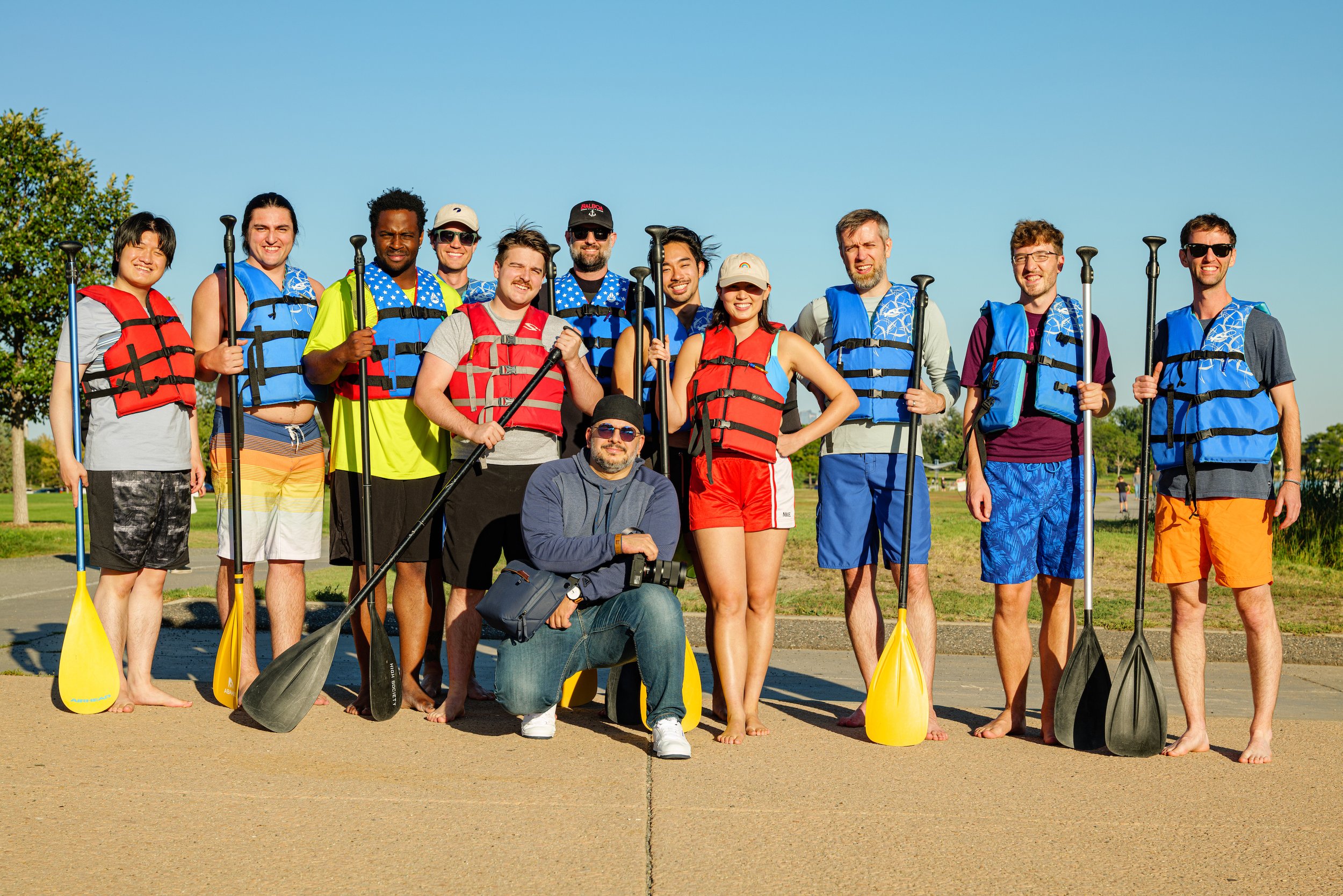How to plan an on-site team retreat
You don’t always have to head off site to host an epic, impactful retreat for your team. Onsite retreats and meetings are becoming popular with the explosion of hybrid and flexible workplaces. Could they be right for your business? How do you plan a team onsite? The most important thing to remember when planning an onsite is to find a way to still make your event feel like a step away from day-to-day work. Create a unique and memorable experience that impacts your business and employees.
We’ve talked all about how to host a team offsite and how to plan one. But, what about a team onsite? While the headlines continue to be peppered with news about a potential recession, many businesses are tightening purse strings, understandably so. But with employee engagement a critical component of retention efforts and keeping morale high, it’s important that you’re still prioritizing face-to-face time between team members in this remote and hybrid world of work.
So, how do you do achieve that while balancing impact and affordability? One option is to start hosting team onsite meetings.
Growing in popularity by the day, companies are starting to bring teams into their semi-occupied office spaces that have been left at least partially unused since March 2020. As most employees aren’t in the office every day, there are still many ways you can create an environment that offers a unique experience
Reasons team onsites may be a good fit for your company
When considering whether to host and onsite or an offsite meeting, there two main factors that make it a well-aligned choice:
1: You have office space available to you
It’s no secret that with remote work climbing in popularity, offices are sitting empty. Office space value in NYC is predicted to decline about 40% due to less demand, and CBRE has shared that office vacancy is the highest it’s been in three decades.
But that doesn’t mean that you’re free from already signed leases or owned property you can’t sell.
So, how do you use your assets to your advantage in this situation?
Some teams are realizing that their offices are better used as an “onsite events hub”, since they’re sitting nearly half-empty most of the time. So, this could be another consideration—will you host just your team onsite, or will you start offering your space for similar meetings?
2: You’re reducing internal event spend
If you’re considering reducing travel budgets or general internal spending, onsites are a great option because they reduce venue costs, AV costs, venue labor fees, and in many cases, employee travel costs if your office is based in a central location. It allows for convenience and cost savings rather than eliminating an important employee morale booster!
The one thing to consider if you do choose an onsite for one of these reasons is that you do need to make it different than the regular day-to-day. One potential con of an onsite is that if it’s not planned intentionally to feel hyped up, exciting, and relevant, it may not provide the ROI you’re looking for. So, soak up the following tips for how to ensure your team onsite creates positive impact.
Automotus team onsite: Read about their event
How to plan a team onsite at your offices
To plan an amazing company onsite, approach planning as if it’s an offsite event. Yes, this may sound counterintuitive. But in reality, you want your onsite to yield the same inspiration, excitement, and relationships that an offsite would. And to do that, you want to plan them in the same way.
You want to ask the following questions to set your team onsite planning foundation:
What do we want to achieve during this onsite meeting?
What have our employees been asking for, or struggling with, and what are common themes on our pulse surveys in the past 6 months?
What are three KPIs that would indicate this style of meeting is a success?
What is our budget?
Do we want there to be time spent co-working, or will it be mainly strategy sessions, training, and/or activities? What do we need to offer in the agenda to meet those goals and KPIs?
Where will we host it? Our offices, a partner’s office space? Rented office space in the town where headquarters are located?
You can find more detailed steps in this post about offsites, but these questions will get you started in your brainstorming on how and why you’re hosting a team onsite.
Tips for a great team onsite strategy
Rotate teams each quarter
One way to ensure that you are using the space effectively is to plan retreats on a quarterly basis. So, each year you know that the engineering team is coming in March, the marketing team in June, and sales in October to close the year strong. This way, you won’t have overlap, and employees will know what time of year they’ll need to block off a few days to head into the office.
Get creative with your space
As we mentioned already, the key to an effective onsite meeting is making sure that it doesn’t feel like any ol’ day at the office. One way to do this is to get creative with your space. If there aren’t team members there daily that need private offices, adopt an open floor plan with collaborative seating that can then be used easily for team onsite brainstorming sessions or training that happen during the time onsite.
Also, get teams moving throughout the building for different sessions! No one likes traveling to an office just to stare at the same four walls all day, every day. That’s why most love remote and hybrid work to begin with.
Create a strategy that’s repeatable
Both of the prior items are leading to one overarching theme—create a repeatable company offsite strategy that you can easily use among each team.
You can create the following one time and use it for every team:
Web invitation and team RSVP tracking
Agenda outline with sessions, lunch and dinner locations, and activities
Hotel blocks or corporate rates for employees to book on own
This will make it easier during team onsite planning because you’ll be doing the same thing, five times, for five different teams, without recreating the wheel or investing greater resources.
Host fun activities and icebreakers
One of the main reasons to host a team onsite is to build those relationships team members can’t build through a computer screen. You can try DIY fun icebreakers that won’t break the bank but will have people learning more about their team and creating genuine friendships!
You can also create an agenda filled with fun virtually-led activities you can do in person, like:
A trip to Italian vineyards and the French countryside via a virtual wine tasting or a cold brew coffee tasting class for the AM coffee break
Creating an on-brand succulent that’s also a cool gift to take home and put in the home office
Participating in a resilience workshop to end the sales year strong with drive, creativity, and passion
See how fun that sounds already!?
But… there are also a couple of things you should avoid when hosting a company onsite
Again, the goal is to make this feel like a meeting that’s hosted away from the office!
Avoid treating local employees differently
One of the ways that you can make a team onsite feel special is to give local employees the option to stay near the office with their team.
If you have a hotel block, extend the option to your local team members so they can have a “staycation” of sorts while bonding with the people they spend time with every day, after hours. No one wants to go home while everyone else is hanging out in the evening enjoying one another’s company!
The team will really appreciate it if you still manage travel, too. If you’re doing an offsite activity that’s an hour or so away from the office, get a van or bus to take the team there together rather than making them carpool in their own vehicles.
The key is to make this feel like an experience, even if it is close to home. This leads us to the next tip.
Avoid requiring attendance on days off
While it can be incredibly difficult to gather teams during traditional office hours due to projects, deadlines, and a laundry list of to-dos, it may hinder the excitement of the team onsite if the team is required to come in during days that are traditionally vacation days or weekends.
For it to feel like a super special bonus, host your company onsite during a slow time of year for the team, where you can take a Thursday and a Friday off from client work, if possible. And if that’s not doable, maybe host the team onsite for the entire week, but manage the agenda in a way that they have half-day co-working sessions and half-day for fun bonding activities, so work is still getting completed!
The ideal team onsite agenda
In reality, our team offsite agenda templates would work perfectly for team onsites as well. The ultimate goal is a perfect mix of fun and play. Use these free event agenda templates for team onsite planning made easy!
Want help creating your team onsite strategy for this year & beyond?
But, sometimes, the templates are just a starting point. You may want to consider recruiting help from a third-party planner who can help you manage the tedious planning process… and all the little details that pop up during planning. Professional planners have their finger on the pulse of the event industry for team-building purposes. They also know how to manage and negotiate budgets, which will save you immense amounts of time and money.
Think help planning could be valuable for your team? Chat with our event experts about whether a team offsite or company onsite is best for your business.


















